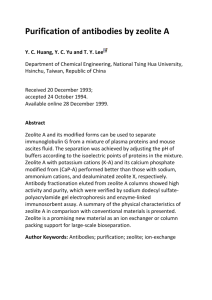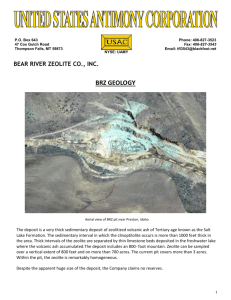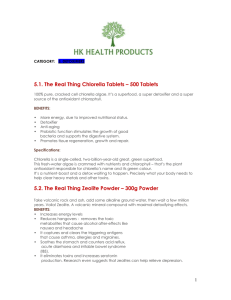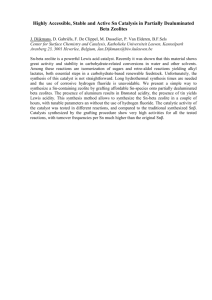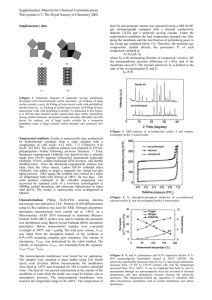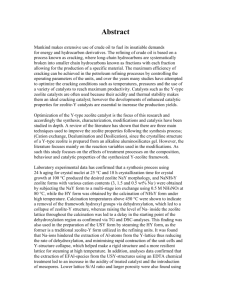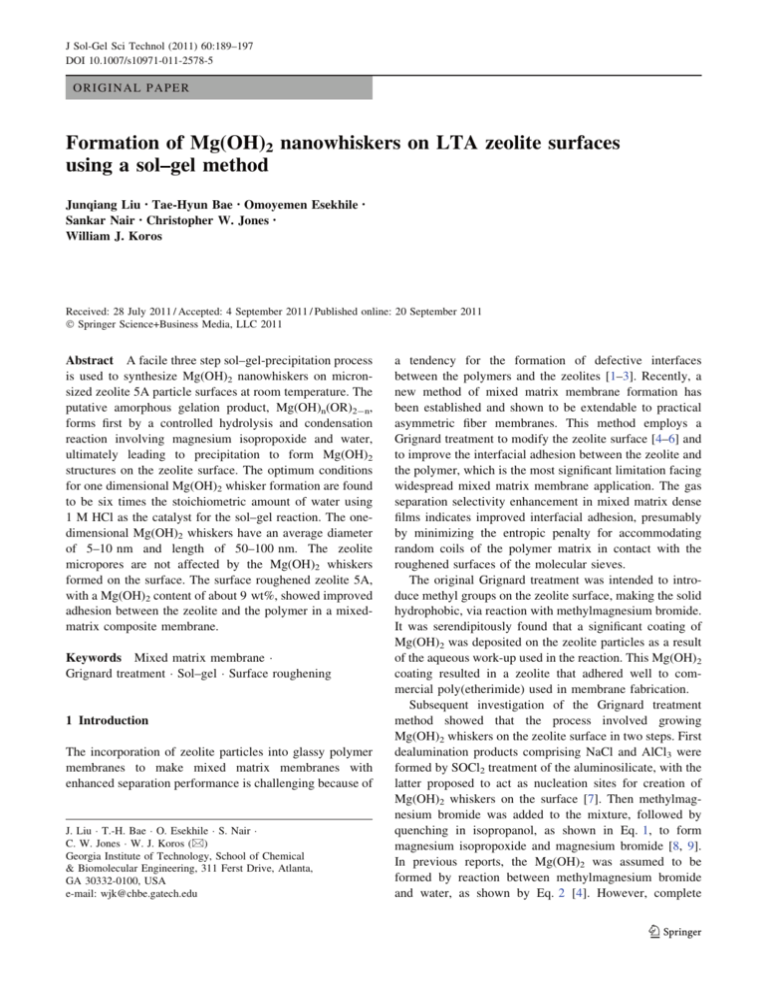
J Sol-Gel Sci Technol (2011) 60:189–197
DOI 10.1007/s10971-011-2578-5
ORIGINAL PAPER
Formation of Mg(OH)2 nanowhiskers on LTA zeolite surfaces
using a sol–gel method
Junqiang Liu • Tae-Hyun Bae • Omoyemen Esekhile
Sankar Nair • Christopher W. Jones •
William J. Koros
•
Received: 28 July 2011 / Accepted: 4 September 2011 / Published online: 20 September 2011
Ó Springer Science+Business Media, LLC 2011
Abstract A facile three step sol–gel-precipitation process
is used to synthesize Mg(OH)2 nanowhiskers on micronsized zeolite 5A particle surfaces at room temperature. The
putative amorphous gelation product, Mg(OH)n(OR)2-n,
forms first by a controlled hydrolysis and condensation
reaction involving magnesium isopropoxide and water,
ultimately leading to precipitation to form Mg(OH)2
structures on the zeolite surface. The optimum conditions
for one dimensional Mg(OH)2 whisker formation are found
to be six times the stoichiometric amount of water using
1 M HCl as the catalyst for the sol–gel reaction. The onedimensional Mg(OH)2 whiskers have an average diameter
of 5–10 nm and length of 50–100 nm. The zeolite
micropores are not affected by the Mg(OH)2 whiskers
formed on the surface. The surface roughened zeolite 5A,
with a Mg(OH)2 content of about 9 wt%, showed improved
adhesion between the zeolite and the polymer in a mixedmatrix composite membrane.
Keywords Mixed matrix membrane Grignard treatment Sol–gel Surface roughening
1 Introduction
The incorporation of zeolite particles into glassy polymer
membranes to make mixed matrix membranes with
enhanced separation performance is challenging because of
J. Liu T.-H. Bae O. Esekhile S. Nair C. W. Jones W. J. Koros (&)
Georgia Institute of Technology, School of Chemical
& Biomolecular Engineering, 311 Ferst Drive, Atlanta,
GA 30332-0100, USA
e-mail: wjk@chbe.gatech.edu
a tendency for the formation of defective interfaces
between the polymers and the zeolites [1–3]. Recently, a
new method of mixed matrix membrane formation has
been established and shown to be extendable to practical
asymmetric fiber membranes. This method employs a
Grignard treatment to modify the zeolite surface [4–6] and
to improve the interfacial adhesion between the zeolite and
the polymer, which is the most significant limitation facing
widespread mixed matrix membrane application. The gas
separation selectivity enhancement in mixed matrix dense
films indicates improved interfacial adhesion, presumably
by minimizing the entropic penalty for accommodating
random coils of the polymer matrix in contact with the
roughened surfaces of the molecular sieves.
The original Grignard treatment was intended to introduce methyl groups on the zeolite surface, making the solid
hydrophobic, via reaction with methylmagnesium bromide.
It was serendipitously found that a significant coating of
Mg(OH)2 was deposited on the zeolite particles as a result
of the aqueous work-up used in the reaction. This Mg(OH)2
coating resulted in a zeolite that adhered well to commercial poly(etherimide) used in membrane fabrication.
Subsequent investigation of the Grignard treatment
method showed that the process involved growing
Mg(OH)2 whiskers on the zeolite surface in two steps. First
dealumination products comprising NaCl and AlCl3 were
formed by SOCl2 treatment of the aluminosilicate, with the
latter proposed to act as nucleation sites for creation of
Mg(OH)2 whiskers on the surface [7]. Then methylmagnesium bromide was added to the mixture, followed by
quenching in isopropanol, as shown in Eq. 1, to form
magnesium isopropoxide and magnesium bromide [8, 9].
In previous reports, the Mg(OH)2 was assumed to be
formed by reaction between methylmagnesium bromide
and water, as shown by Eq. 2 [4]. However, complete
123
190
J Sol-Gel Sci Technol (2011) 60:189–197
elucidation of the reaction pathway was not achieved, and
the original synthesis is somewhat difficult to control.
2.3 Recovery of Mg(OH)2 coated zeolites
2CH3 MgBr þ 2ðCH3 Þ2 CHOH
! 2CH4 þ MgBr2 þ Mg(OCHðCH3 Þ2 Þ2
ð1Þ
2CH3 MgBr þ 2H2 O ! 2CH4 þ MgBr2 þ MgðOHÞ2
ð2Þ
The particles and reaction products were separated from
the dispersion by a centrifuge. The supernatant was decanted and isopropanol was added to wash away the
remaining toluene, with sonication at 55 W power for 30 s
duration to assist the washing. This sonication and washing
treatment was repeated three times. Zeolite particles were
then centrifuged out of the isopropanol and water was then
added, followed by sonication for three 30-second periods.
The sonication and centrifuging procedures were repeated
until the conductivity of the supernatant dropped below
30 lS m-1. The final collected particles were dried overnight in a vacuum oven at 150 °C.
In this work, we have reconsidered the reaction pathway
in light of what is known about sol–gel chemistry of
magnesium alkoxides, such as the species shown in Eq. 1.
In addition, a streamlined, highly reproducible process has
been developed that facillitates efficient coating of the
zeolite crystals with Mg(OH)2 nanostructures without the
need for surface pretreatment.
2 Experimental
Zeolite 5A particles, with an average size of 2 lm, were
purchased from Aldrich. Toluene (99.8% purity), tetrahydrofuran (THF 99.8% purity), isopropanol (99.5% purity),
and methylmagnesium bromide (3.0 M solution in diethyl
ether) were purchased from Aldrich and used without
further purification. All chemicals were transferred into
reactions vessels carefully through a syringe to avoid
exposure to atmospheric moisture.
2.1 Synthesis of magnesium sol in the presence
of zeolites
A mass of 8 g of zeolite 5A particles and a TeflonÒ coated
magnetic stir bar were placed in a 200 mL reaction flask.
All the particles and glassware were dried overnight at
150 °C in a vacuum oven. Then, 80 mL of toluene and
20 mL of methylmagnesium bromide were added into the
sealed reaction flask. The dispersion was kept in a sonication bath (Branson 1510) overnight, before 80 mL of
isopropanol were added slowly to react with the methylmagnesium bromide. The resulting milky sol dispersion
product was divided into six 50 mL centrifuge vials.
2.2 Gelation of magnesium sol in the presence
of zeolites
Water was then added into the vials of the sol dispersion
dropwise. Sonication was used to assist the H2O dispersion
after addition of four drops of water, via a 55 W sonication
horn (VCX130, Sonics) for 10 s. This process was repeated
5–10 times until the desired amount of water was added.
The pH of the H2O added was adjusted to 7.0, 1.0 and 0 by
adding the appropriate amount of 35 wt% HCl solution
into the de-ionized water. The resultant sol–gel dispersion
was aged overnight without disruption.
123
2.4 Mixed matrix membrane formation
A 25 wt% polymer dope was prepared with dried fluorinated polyimide 6FDA-DAM (Mw = 49,300) [10] and
tetrahydrofuran (THF). The dope was rolled on a mixer
overnight to dissolve the polymer. The treated or untreated
zeolite molecular sieve particles were dried in a vacuum
oven at 180 °C overnight, to remove moisture in the pores.
A small amount of tetrahydrofuran was then added to the
dried sieve in a 8 mL vial and a few bursts of sonication
were applied to assist the dispersion of the sieve in THF.
The polymer dope was then added to the sieves to achieve
the desired particle-to-polymer ratio. The polymer-sieve
dope was rolled and sonicated to assist the dispersion of
sieves in the dope. The dopes were poured onto a glass
plate, which was placed in a glove bag pre-saturated with
THF vapor for at least 4 h. The dope was cast into the
desired thickness (typically 30 micron) using a draw knife
with appropriate specific clearance. The film was left in the
glove bag overnight to let the THF solvent evaporate
slowly. The film was further dried in a vacuum oven at
180 °C overnight to remove remaining solvent.
Butane isomer permeation tests on these films were done
using a downstream-vacuum, pressure build up method,
with an upstream pressure of 25 psi at 100 °C. The pressure
decay method was used to measure the n-butane sorption
capacity in the zeolite 5A micropores before and after
surface treatments, using a method previously reported
[10].
SEM images were obtained with a LEO 1550, equipped
with a thermally assisted field emission gun operating at
5 kV. Elemental content was analyzed by Electron Dispersion Spectroscopy (EDS) measurements. Three measurements were done and an average was taken for each
sample. Powder X-ray diffraction (XRD) patterns were
obtained on a Philips X’pert diffractometer equipped with
X’celerator using Cu Ka radiation.
J Sol-Gel Sci Technol (2011) 60:189–197
191
3 Results and discussion
An efficient way to have the majority of Grignard reagent
form Mg(OH)2 is via first conversion of the Grignard to a
magnesium alkoxide, followed by controlled hydrolysis
and condensation of the magnesium sol.
Magnesium alkoxides have been widely used to synthesize Mg(OH)2 and MgO with high surface area porous
structures through sol–gel reactions, consisting of hydrolysis reactions (Eqs. 3, 4) and condensation reactions
(Eqs. 5, 6) [11–15]. It is known that there are two critical
factors affecting the sol–gel products: (1) the amount of
water and (2) the pH of the reactions. In the present work, a
sol–gel-precipitation method is used to synthesize Mg(OH)2
whiskers on zeolite LTA surfaces, and the whisker morphology is controlled by the sol–gel reaction conditions via
manipulation of the amount of water and the pH.
MgðOCHðCH3 Þ2 Þ2 þ H2 O
þ ðCH3 Þ2 CHOH
!
HOMgOCHðCH3 Þ2 þ H2 O
HOMgOCHðCH3 Þ2
ð3Þ
!
HOMgOH þ ðCH3 Þ2 CHOH
ð4Þ
MgOCHðCH3 Þ2 þ MgOH
!
MgOMg
þ ðCH3 Þ2 CHOH
MgOH þ MgOH
ð5Þ
!
MgOMg þ H2 O:
ð6Þ
3.1 Effect of magnesium/water ratio and pH on sol–gel
Mg(OH)2 morphology
The most important parameter for the sol–gel reaction is
the amount of water used, which determines the extent of
the hydrolysis and condensation reactions involving the
magnesium alkoxide. The stoichiometric amount of water
needed to react with magnesium isopropoxide was calculated according to Eq. 7. The amount of magnesium isopropoxide generated by methylmagnesium bromide, as
shown in Eq. 1, in each vial is 0.005 mol. One stoichiometric (denoted as 1S) amount of water to react with the
magnesium isopropoxide according to Eq. 7 is 0.18 grams.
MgðOCHðCH3 Þ2 Þ2 þ 2H2 O
þ 2ðCH3 Þ2 CHOH:
!
MgðOHÞ2
ð7Þ
Research showed that hydrolysis reactions of
magnesium alkoxides are equilibrium reactions, and the
amount of Mg(OH)2 generated depends on the reaction
extent [11, 14]. Figure 1 shows the final Mg(OH)2
morphology on a zeolite 5A surface after treatments with
different amounts of added water. Treatment with 2S
amount of water showed bare zeolite 5A surfaces. This is
likely because the hydrolysis reaction (Eq. 7) does not
proceed to a large extent under these conditions, and the
magnesium isopropoxide remains largely unreacted. The
zeolite and sol–gel product mixture was later washed
several times using de-ionized water to remove the water
soluble reaction products. During the water washing steps,
the water soluble magnesium isopropoxide is washed away
and little solid forms on the zeolite surfaces. Therefore,
during the water washing step, the remaining magnesium
isopropoxide does not hydrolyze and form Mg(OH)2 to any
appreciable extent. This supposition is consistent with
visual observation of the reaction filtrate, which remained
clear for an extended period of time and only became
cloudy after a few weeks.
When the amount of water is 4S to 6S, Mg(OH)2
solids in the form of short whiskers begin to form on the
zeolite surfaces. This is likely because Mg(OH)n(OR)2-n
(0 \ n \ 2) species are formed as hydrolysis products, and
these species are partially insoluble in water, and precipitate onto the zeolite surfaces during the water washing step.
As the water amount is increased, more water insoluble
hydrolysis product is generated and precipitated onto the
zeolite surfaces. As shown in Fig. 1, more plate-like
Mg(OH)2 is formed on the zeolite surfaces at 8S water
addition. With water addition in excess of 12S, the milky
dispersion begins to phase separate into a clear top layer
and white, cloudy, bottom layer. It can be concluded that at
pH = 7, only short whiskers or flakes of Mg(OH)2 can be
generated after addition of varying amounts of water.
It is well known that reaction pH can affect the morphology of sol–gel products. Under acidic conditions, the
hydrolysis reactions are promoted, condensation reactions
are depressed, and one-dimensional structures, such as
nanoparticles, whiskers etc., can be generated [16]. In the
well studied sol–gel silicate case, acid-catalyzed hydrolysis
with low H2O:Si ratios produces weakly branched ‘‘polymeric’’ sols, whereas base-catalyzed hydrolysis with large
H2O:Si ratios produces highly condensed ‘‘particulate’’
sols. To our knowledge, there has been no relevant prior
research on the pH effects on Mg(OH)2 morphologies
using the sol–gel method.
In this work, the pH of the water was controlled by
making 1 M (pH = 0) and 0.1 M (pH = 1) HCl solutions.
The acid solutions were added to the sol dispersion
replacing the pure de-ionized water that was used in the
base case. The other steps were performed exactly the
same.
Figure 2 shows the different morphologies of Mg(OH)2
whiskers on the zeolite surfaces after treatments with different amounts of water of different pH. Longer whiskers
were formed in the more acidic environment. The whiskers
from treatment at pH = 1 appeared to be short and perpendicular to the zeolite surface. The Mg(OH)2 content
was about 3.0 wt% of the total solid, as shown in Table 1.
The whiskers from treatment at pH = 0 were longer and
123
192
J Sol-Gel Sci Technol (2011) 60:189–197
Fig. 1 Different morphologies of Mg(OH)2 formed by adding various amount of water (pH = 7.0): a, b, c, d have two, four, six and eight times
stoichiometric amount of water
interlocked. The Mg(OH)2 content was about 9 wt% of the
total solid, converted from the atomic percentage. These
interconnected whisker structures may provide more stable
polymer chain entanglement in composite films, as discussed below. The density of the whiskers on the zeolite
surface was not evaluated exactly, but there seems to be no
dramatic difference between the different treatments as
judged by SEM images. The whisker density may be
controlled by the density of nucleating sites on the zeolite
surface, which is determined by the surface properties of
the molecular sieve.
Figure 3 shows the Mg(OH)2 morphologies prepared via
addition of more than 6S equivalents of water. In these
cases, free Mg(OH)2 particles appear to have formed in
solution and then deposited on the zeolite surfaces. This is
likely due to homogeneous nucleation at higher hydrolysis
levels.
3.2 Magnesium sol formation
Figure 4 shows the images of LTA zeolites at various
stages of the Mg(OH)2 functionalization process under a
fixed set of conditions (6S H2O, pH = 0). After quenching
the methylmagnesium bromide with isopropanol, it is well
known that magnesium bromide and magnesium isopropoxide are formed [8, 9]. Smooth zeolite surfaces were
observed after this step. After water addition, an amorphous product on zeolite surface was observed, but no
whisker morphology appeared to present on the zeolite
123
surface. After the first water wash, the zeolite surfaces were
found to be covered by a thick layer of sol–gel product.
After three water washes, only Mg(OH)2 whiskers were
observed on the zeolite surfaces.
To better understand the process, the same treatment
without addition of zeolite was performed. The products
were collected by centrifuge analyzed by XRD (shown in
Fig. 5). The magnesium sol, consisting of magnesium
bromide and magnesium isopropoxide, showed a clear
crystal pattern. After adding water, the crystalline pattern
disappeared, consistent with the amorphous morphology
suggested in Fig. 4. The hydrolysis and condensation
reactions started after water was added, and the intermediate products can associate into polymer-like gels by
–Mg–O–Mg– bonding or hydrogen bonding between
–Mg–OH groups [11], as shown in Fig. 6. Indeed, after
addition of 5S of water, the gel formation was inferred by
an increase of viscosity.
Although there should be an equimolar amount of
magnesium bromide and magnesium isopropoxide after the
isopropanol quenching step, no strong MgBr2 peaks were
observed in the XRD pattern after the water addition step.
This is probably because the MgBr2 salt is strongly associated into the gel structure shown in Fig. 6, together with
water. In this situation, the magnesium gel structures are
probably surrounded not only by toluene and isopropanol
solvent, but possibly by water and hydrated ions of Mg2?,
Br-. It has been reported that the soluble salts are typically
homogeneously dispersed in the sols to give well dispersed
J Sol-Gel Sci Technol (2011) 60:189–197
193
Fig. 3 Independently formed Mg(OH)2 after over amount of water
addition
Fig. 2 Different morphologies of Mg(OH)2 formed on 5A surfaces,
by adding six times of stoichiometric amount of water at various pHs
mixture products [16]. It is unknown whether the presence
of MgBr2 salts in this work affected the reactions of
magnesium isopropoxide and the magnesium hydroxide
precipitation process. The XRD pattern of the gel displayed
little crystallinity. During the isopropanol wash that was
used to remove the toluene from the sol–gel product, the
amorphous nature of sol–gel product did not change. When
the isopropanol phase was replaced by water, however, the
collected sol–gel product showed a clear crystalline pattern
associated mainly with Mg(OH)2, and small amount of
other impurities, most probably MgBr2. After three of
water washes assisted by sonication, only the strong
Mg(OH)2 pattern was observed. This agrees with images in
Fig. 4 that suggest that most of the MgBr2 and deposited
particles were removed after three sonication and water
washes. The conductivity of supernatant water for the first
three water washes drops from few thousand to about
Table 1 Elemental composition of different 5A particles by EDS measurement
Atomic percentage %
O
Na
Bare 5A
54.3
4.9
GT-5A (6S H2O, pH = 7.0)
63.7
3.2
Mg
Al
Si
Ca
16.0
16.8
8.1
0.4
13.6
13.8
5.4
GT-5A (6S H2O, pH = 1.0)
65.9
2.8
1.1
12.3
12.2
5.4
GT-5A (6S H2O, pH = 0)
61.9
3.5
3.3
13.2
12.4
5.8
123
194
Fig. 4 Morphology development at different stages of treatment
(6S H2O, pH = 0); a zeolite in sol–gel precursor (after IPA
quenching); b zeolite in sol–gel (after water addition); c zeolite in
J Sol-Gel Sci Technol (2011) 60:189–197
precipitated sol–gel (after one water wash); d, Zeolite in precipitated
sol–gel (after three water wash)
Fig. 6 Examples of polymer like interconnected gel structures
formed by hydrolysis and condensation reactions, –OR stands for
the unhydrolyzed isopropoxyl group
Fig. 5 XRD patterns of sol–gel products at different steps of
treatment
was completed and Mg(OH)2 was generated with the
abundant water washing.
3.3 Mg(OH)2 precipitation
100 lS m-1, which is probably due to the MgBr2 being
washed off.
It can be concluded that the Mg(OH)2 whiskers were
formed by a sol–gel-precipitation mechanism, as shown in
Fig. 7. The magnesium isopropoxide sol first reacted with
water and was transformed into a polymer like amorphous
gel. The amorphous gel, made of Mg(OH)n(OR)2-n then
precipitated onto the zeolite surfaces because of its limited
solubility in water. The uncompleted hydrolysis reaction
123
It appears the gel precipitated preferrentially onto the
zeolite surfaces, rather than forming homogeneous particles in solution. This suggests the zeolite surface provided
heterogeneous nucleating sites. There is typically a high
concentration of hydroxyl groups on zeolite surfaces [17].
Methylmagnesium bromide may react with the surface
hydroxyl groups as shown in Eq. 8 [18]. Si–O–Mg– bonds
can also be generated by condensation reactions, as shown
by Eq. 9, between silanol groups and magnesium alkoxides
J Sol-Gel Sci Technol (2011) 60:189–197
195
Fig. 7 Morphology evolutions
from magnesium alkoxide to
magnesium hydroxide, during
the sol–gel precipitation steps
[19]. Both of these routes leading to –Si–O–Mg– bonding
could provide nucleating sites for Mg(OH)2 precipitation
and the potential for covalent bonding between the zeolite
and Mg(OH)2 structures. Additional research will be
required to elucidate the true mechanism.
SiOH þ CH3 MgBr ! SiOMgBr þ CH4
ð8Þ
!
SiOH þ MgðORÞðOHÞ SiOMgOH þ ROH:
ð9Þ
3.4 Polymer zeolite adhesion enhancement
by Mg(OH)2 whiskers
It has been reported that the Mg(OH)2 nanowhiskers on
zeolite surfaces may provide molecular scale interlocking
interactions with polymer chains and enhance the adhesion
between the zeolite and polymer [4]. The adhesion
enhancement in this work was evaluated by butane isomer
permeation tests using mixed matrix membranes containing treated 5A zeolite particles.
Zeolite 5A has pores that allow n-butane to pass through
but totally block the passage of i-butane, i.e., show infinite
selectivity for the normal butane isomer [20]. By adding
zeolite 5A into polymeric membranes, the butane isomer
performance should be enhanced if the zeolite and polymer
are properly adhered. To check for the possibility for
permeation of n-butane in zeolite 5A before and after the
magnesium treatment, sorption measurements were performed and the results are shown in Fig. 8. The n-butane
sorption capacity was not changed by treatment under the
different conditions. The i-butane adsorbs to essentially no
extent in all the samples. Therefore, the micropores of the
zeolite were not significantly affected by the acidic water
added in the treatments. The ratio between HCl and magnesium isopropoxide was about 1:5, under the 6S water
addition conditions, pH = 0. The stability of the zeolite
framework was good, as confirmed by the only small
change of n-butane sorption capacity in zeolite 5A
micropores.
A defective interface (so called ‘sieve-in-a-cage’ morphology) was formed when bare zeolite 5A was added into
the 6FDA-DAM polymer, as shown in Fig. 9. Gas molecules can bypass the zeolite through the defective interfaces. Pinholes can be generated if voids are interconnected
in extreme cases. The treated zeolite with the most whisker-like Mg(OH)2 morphology was the sample treated with
6S water addition, at pH = 0 (Fig. 10). In the mixed matrix
membrane containing the treated zeolite, the zeolite-polymer interfacial adhesion was improved significantly. The
permeation results for these membranes are shown in
Table 2. The mixed matrix membrane containing bare 5A
had increased n-butane permeability, but the butane isomer
selectivity was far lower than that in pure polymer. This is
Fig. 8 Sorption isotherm of n-butane in bare and treated 5A samples,
at 50 °C. The points are from experimental results, the line is a
Langmuir fitting
123
196
J Sol-Gel Sci Technol (2011) 60:189–197
Fig. 9 Cross section of mixed matrix films containing 6FDA-DAM polymer and 25 wt% treated (6S water, pH = 0) 5A (a, b) and bare 5A (c, d)
rates of n-butane diffusion were about the same in the
6FDA-DAM polymer and zeolite 5A, which will be discussed in a separate paper. The selectivity enhancement in
the mixed matrix membrane confirms the good adhesion
suggested by the SEM images.
4 Conclusion
Fig. 10 Mg(OH)2 whiskers formed on 5A surfaces at treatment
condition: 6 times of stoichiometric amount of water, pH = 0
Table 2 Permeability and selectivity of C4 s in polymeric and mixed
matrix membranes, 100 °C, 25 psi at upstream, GT-5A is done with
condition: pH = 0, 6S water
Permeability
nC4 [Barrer]
Selectivity
nC4/iC4 [-]
6FDA-DAM
3.2 ± 0.2
21 ± 2
25 wt%-bare 5A-6FDA-DAM
4.5 ± 0.3
2.5 ± 0.3
25 wt%-GT-5A -6FDA-DAM
3.3 ± 0.2
25 ± 2
possibly due to pinholes generated by the defective interfaces. In the mixed matrix membrane containing treated
zeolite 5A, the butane isomer selectivity increased about
20% due to the addition of i-butane blocking 5A particles.
The n-butane permeability was not increased because the
123
The three step sol–gel-precipitation developed based on
knowledge of the probable mechanism of Mg(OH)2 formation on the zeolite surface successfully resulted in
magnesium hydroxide nanowhisker functionalized zeolite
5A. Magnesium isopropoxide, the precursor for the sol–gel
reaction, was formed by quenching the methylmagnesium
bromide with isopropanol. After controlled water addition,
the hydrolysis and condensation reactions started, and
gelation occurred. The amorphous polymer-like Mg(OH)n
(OR)2-n then precipitates out of the water solution and
onto the zeolite surfaces, because of its limited solubility.
The amount of added water determined the extent of the
hydrolysis reactions, and the composition of Mg(OH)n
(OR)2-n formed. When water was not added, Mg(OH)n
(OR)2-n was largely Mg(OR)2, and nothing was formed on
the zeolite surface, because the water soluble Mg(OR)2 was
washed away. When more water was added, Mg(OH)n
(OR)2-n trends closer to Mg(OH)2 in composition and
precipitate out of water solution. The amount of Mg(OH)2
formed was controlled by the hydrolysis extent via the
amount of water added. The addition HCl affected the
J Sol-Gel Sci Technol (2011) 60:189–197
hydrolysis and condensation reactions, and the structure of
polymer gels formed. The whisker morphology was formed
using acidic water for the sol–gel reactions. The formation
of Mg(OH)2 whiskers on the zeolite surfaces showed little
effect on the microporosity of the zeolite 5A. The
Mg(OH)2 whiskers on the zeolite surfaces helped the
interfacial adhesion between the zeolite and polymer,
possibly by providing more surface area for entanglement
of the polymer chains.
197
4.
5.
6.
7.
8.
9.
10.
11.
Acknowledgment The authors want to thank ExxonMobil and the
King Abdullah University of Science and Technology (Award No.
KUS-I1-011-21) for sponsoring this research. We are also grateful to
Harry Deckman, Edward Corcoran and Ben McCool for helpful
suggestions.
12.
References
17.
18.
1. Koros WJ, Mahajan R (2000) J Membr Sci 175:181–196
2. Mahajan R, Burns R, Schaeffer R, Koros WJ (2000) J Appl
Polym Sci 86:881–890
3. Moore T, Koros WJ (2005) J Mol Struct 739:87–98
13.
14.
15.
16.
19.
20.
Shu S, Husain S, Koros WJ (2007) Chem Mater 19:4000–4006
Shu S, Husain S, Koros WJ (2007) J Phys Chem C 111:652–657
Husain S, Koros WJ (2007) J Membr Sci 288:195–207
Shu S, Husain S, Koros WJ (2007) Ind Eng Chem Res
46:767–772
Fieser LF (1956) Organic chemistry. Reinhold, New York
Bruice PY (2007) Organic chemistry. Pearson Prentice Hall, New
Jersey
Liu J, Bae TH, Qiu W, Nair S, Jones CW, Chance RR, Koros WJ
(2009) J Membr Sci 343:157–163
Diao Y, Walawender WP, Sorensen CM, Klabunde KJ, Ricker T
(2002) Chem Mater 14:362–368
Utamapanya S, Klabunde KJ, Schlup JR (1991) Chem Mater
3:175–181
Stengl V, Bakardjieva S, Maikova M, Bezdi P, Subrt J (2003)
Mater Lett 57:3998–4003
Lopez T, Garcia-Cruz I, Gomez R (1991) J Catal 127:75–85
Francis LF (1997) Mater Manuf Process 12:963–1015
Brinker CJ (1990) Sol-gel science. Academic Press, Inc., New
York
Ward JW (1967) J Catal 9:225–236
Sato M, Kanbayashi T, Kobayashi N, Shima Y (1967) J Catal
7:342–351
Yoon JG (1995) Appl Phys Lett 66:2661–2663
Karger J (1992) Diffusion in zeolites. Wiley, New York
123

